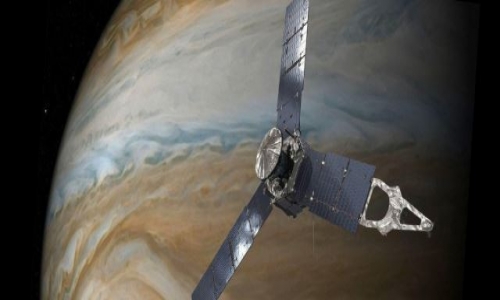

 5:23:29
5:23:29  2024-10-06
2024-10-06  545
545

A trio of ostars just under 5,000 light-years away has absolutely smashed a long standing record.
TIC 290061484 is a system of gravitationally bound stars consisting of a tightly-orbiting binary pair with a third star that circles both. Astonishingly, they're so close together the entire system would fit inside the orbit of Mercury.
And that's not all. The tight trio seems to have another friend; there are hints of a fourth star describing a path at a much greater distance.
All three of the stars in the central trinary are on a collision course, destined to collide, merge, go supernova, and leave behind a single neutron star, in around 20 million years.
The discovery was made using the TESS exoplanet-hunting space telescope, which is optimized for detecting the minute changes in the brightness of a star that indicate an orbiting world.
Systems of stars that eclipse each other along our line of sight also demonstrate changes in brightness, as the stars pass in front of each other and block at least some of each other's light. TESS's observations can detect these brightness changes, too. This is a powerful tool for finding these systems, because, from the distance at which we see them, they usually just look like a single star.
This is the case with the central trinary of TIC 290061484. The orbital plane on which they are all aligned is pretty much edge-on to our line of sight, meaning that we're treated to different eclipse configurations as the three stars go about their cosmic dance.
A team of scientists led by astrophysicist Veselin Kostov of NASA's Goddard Space Flight Center discovered the system after an extensive analysis of TESS data. They used a machine learning algorithm to filter the data based on the expected signal of star system eclipses, and then set a tiny army of citizen scientists loose on the results to refine it further.
"We're mainly looking for signatures of compact multi-star systems, unusual pulsating stars in binary systems, and weird objects," says physicist Saul Rappaport of the Massachusetts Institute of Technology.
"It's exciting to identify a system like this because they're rarely found, but they may be more common than current tallies suggest."
Once they had identified the system as one of interest, the researchers could then analyze the changes in its light to determine its characteristics.
The two stars making up the central binary clock in at 6.85 and 6.11 times the mass of the Sun, with an orbital period of just 1.8 days.
The third star has a mass of 7.9 times the Sun's and orbits the central pair with a period of 24.5 days. That period blows the previous known smallest trinary, with an orbital period of 33 days, out of the water.
Finally, the probable fourth star would have a mass of about 6.01 times the mass of the Sun. It is estimated to circle the central trinary on a much, much wider orbit of about 3,200 days.
Stars are born from abnormally dense regions of matter within vast clouds of gas. Usually, such clouds are speckled with a number of baby stars, some of which drawing close enough to merge, others to spend their lives together locked in orbit.
Most of the stars in the Milky Way galaxy are in systems like these. When you look up into the night sky, more than half the stars you see are actually multiple stars, too distant to discern.
We know there are multiple-star systems out there that we haven't yet identified. This discovery suggests that there may be many more out there than we imagined. The next step will be to turn the upcoming Nancy Grace Roman Space Telescope to the task of finding them, once it reaches the skies.
"Before scientists discovered triply eclipsing triple star systems, we didn't expect them to be out there," says astronomer Tamas Borkovits of the Baja Observatory of The University of Szeged in Hungary. "But once we found them, we thought, well why not? Roman, too, may reveal never-before-seen categories of systems and objects that will surprise astronomers."
Reality Of Islam |
|

We wash our

Astronomers

Researchers

The theory
 9:3:43
9:3:43
 2018-11-05
2018-11-05
10 benefits of Marriage in Islam
 7:5:22
7:5:22
 2019-04-08
2019-04-08
benefits of reciting surat yunus, hud &
 9:45:7
9:45:7
 2018-12-24
2018-12-24
advantages & disadvantages of divorce
 11:35:12
11:35:12
 2018-06-10
2018-06-10
 6:0:51
6:0:51
 2018-10-16
2018-10-16
 7:0:55
7:0:55
 2022-05-17
2022-05-17
 6:14:3
6:14:3
 2023-01-18
2023-01-18
 11:2:27
11:2:27
 2022-10-06
2022-10-06
 9:39:36
9:39:36
 2022-12-28
2022-12-28
 5:58:12
5:58:12
 2021-12-18
2021-12-18
 3:18:29
3:18:29
 2022-12-24
2022-12-24
 4:2:19
4:2:19
 2022-10-10
2022-10-10
 5:41:46
5:41:46
 2023-03-18
2023-03-18
| LATEST |